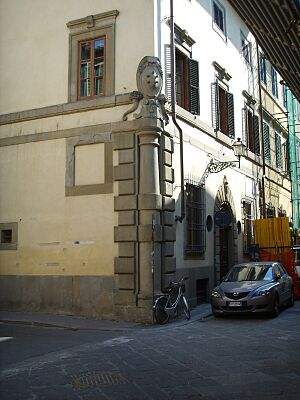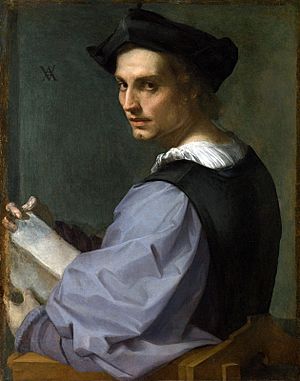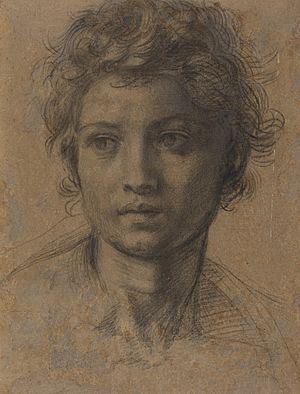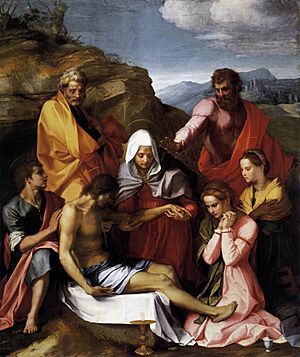Andrea del Sarto facts for kids
Quick facts for kids
Andrea del Sarto
|
|
|---|---|
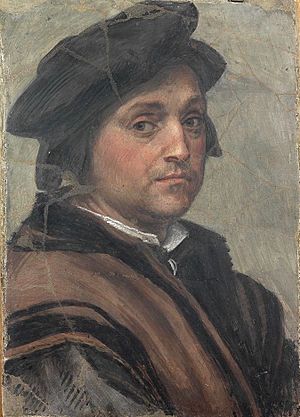
Self-portrait
|
|
| Born |
Andrea d'Agnolo di Francesco di Luca
16 July 1486 Florence, Republic of Florence (present-day Italy) |
| Died | before 29 September 1530 (aged 44) Florence, Republic of Florence (present-day Italy)
|
| Nationality | Tuscan Italian |
| Known for | Painting |
|
Notable work
|
Madonna of the Harpies Nativity of the Virgin |
| Movement | High Renaissance Mannerism |
Andrea del Sarto (born July 16, 1486 – died September 29, 1530) was a famous Italian painter from Florence, Italy. He lived during a time known as the High Renaissance and the start of Mannerism. The High Renaissance was a period when art reached new heights of beauty and skill. Mannerism was a style that followed, often showing figures in unusual poses or with exaggerated features.
Andrea del Sarto was known for many things. He was great at painting frescoes, which are paintings done on wet plaster walls. He also painted beautiful altar-pieces, portraits, and was skilled with drawing and using colors. During his life, people called him an artist "without errors" (senza errori in Italian). However, after he died, other famous artists like Leonardo da Vinci, Michelangelo, and Raphael became even more well-known.
Contents
Andrea del Sarto's Early Life and Training
Andrea del Sarto was born in Florence on July 16, 1486. His real name was Andrea d'Agnolo di Francesco di Luca. His father, Agnolo, was a tailor. Because of this, Andrea became known as "del Sarto," which means "tailor's son" in Italian.
When he was young, Andrea learned from different artists. Around 1494, he became an apprentice to a goldsmith. Later, he worked with a woodcarver and painter named Gian Barile until 1498. According to a writer named Vasari, Andrea then learned from Piero di Cosimo and later from Raffaellino del Garbo.
Andrea and his friend Franciabigio decided to open their own art studio together. One of their first projects was a painting called Baptism of Christ. It was part of a series of monochrome (one-color) frescoes for a group in Florence. Andrea's style became very unique. He was especially good at using colors and creating a certain mood in his paintings. He also made his figures look natural and show real feelings.
Famous Frescoes in Florence
From 1509 to 1514, Andrea del Sarto worked on many frescoes at the Basilica della Santissima Annunziata di Firenze church in Florence. He painted seven frescoes in the church's courtyard. Five of these showed the life and miracles of Filippo Benizzi, a saint. Andrea painted these quickly. They showed the saint healing a sick person, predicting bad things for some people, and helping a girl who was believed to be possessed.
The last two frescoes in this series showed a child being healed at the saint's deathbed and sick adults and children getting better from touching his clothes. All five of these were finished by 1510. Andrea also painted two more frescoes in the courtyard, but with different subjects. These included a Procession of the Magi (which has a self-portrait of Andrea) and a Nativity of the Virgin. People admired these paintings a lot, especially how correct the outlines were. This is why he earned the nickname "Andrea senza errori" (Andrea the perfect).
Around 1512, he painted an Annunciation for the Church of San Gallo and a Marriage of Saint Catherine. By 1514, Andrea finished his last two frescoes in the courtyard, including his famous Nativity of the Virgin. This painting combined ideas from Leonardo da Vinci, Domenico Ghirlandaio, and Fra Bartolomeo.
Andrea's Visit to France
Before 1516, some of Andrea del Sarto's paintings were sent to the French King. This led to an invitation from King François I in 1518. Andrea traveled to Paris in June of that year with his student, Andrea Squarzzella. He left his wife, Lucrezia, in Florence.
According to Giorgio Vasari, who was Andrea's student and wrote about his life, Lucrezia wrote to Andrea and asked him to come back to Italy. The King agreed, but he expected Andrea to return to France soon. The King also gave Andrea money to buy art for the French Court. Vasari's story says that Andrea used this money to buy a house for himself in Florence instead. This story made Andrea's reputation seem bad and suggested he could never go back to France. However, many historians today believe this story is not true.
Later Works in Florence
In 1520, Andrea continued his work in Florence. He painted Faith and Charity. He also created paintings like the Dance of the Daughter of Herodias, the Beheading of the Baptist, and the Presentation of his head to Herod. In 1523, he painted an Apparition of the Angel to Zacharias.
In the autumn of 1524, Andrea painted the Visitation. He had returned from a town called Luco because of an outbreak of bubonic plague in Florence. In 1525, he painted the Madonna del Sacco in the Annunziata cloister. This painting shows Mary leaning against a sack. The way Mary's dress flows and her gaze show how Andrea influenced his student Jacopo Pontormo.
In 1523, Andrea made a copy of a famous portrait of Pope Leo X by Raphael. Andrea's copy is now in a museum in Naples, while the original is in the Pitti Palace in Florence. The original painting belonged to Ottaviano de' Medici, and the Duke of Mantua wanted it. Ottaviano didn't want to give up the original, so he asked Andrea to make a copy. Andrea's copy was so good that even Giulio Romano, who had worked on the original, was completely fooled! He only believed it was a copy when Vasari pointed out a secret mark on the canvas.
Andrea's last work at the Scalzo was the Nativity of the Baptist (1526). The next year, he finished his last important painting, a Last Supper at San Salvi. In this painting, all the people look like real portraits. The church is now a museum dedicated to this painting.
Several of Andrea's paintings were once thought to be self-portraits. However, many of these are now known to be portraits of other people. There is a self-portrait of him as a young man at Alnwick Castle. Another youthful portrait is in the Uffizi Gallery, and the Pitti Palace has more than one.
Madonna of the Harpies
The Madonna of the Harpies is a painting of the Virgin Mary and baby Jesus standing on a platform. They are flanked by two saints, and two angels are at their feet. The platform has carvings of female figures that look like harpies, which is how the painting got its name. This painting was finished in 1517 for a convent and is now in the Uffizi Gallery.
This painting shows Andrea's unique style. The figures have a feeling similar to those by Leonardo da Vinci. The way the figures are arranged in a stable pyramid shape gives the painting a strong, unified look. Andrea's careful and balanced style was more classical than Leonardo's, but less strict than some other artists like Fra Bartolomeo.
Andrea del Sarto's Personal Life
Andrea married Lucrezia (del Fede) on December 26, 1512. She was a widow. Lucrezia appears in many of Andrea's paintings, often as the Virgin Mary.
Andrea died in Florence at the age of 44 during an outbreak of Bubonic Plague in September 1530. He was buried simply in a church. Some stories say his wife did not take care of him during his illness. However, the plague was very contagious, so it's possible Lucrezia was simply afraid of catching the deadly disease herself. She lived for 40 years after Andrea died.
How Andrea del Sarto is Remembered
Michelangelo thought highly of Andrea del Sarto's skills. In 1524, Michelangelo even introduced Giorgio Vasari to Andrea's art studio. Many artists in Florence followed Andrea's style, including Jacopo Pontormo, Rosso Fiorentino, Francesco Salviati, and Jacopino del Conte. Other students and helpers included Bernardo del Buda and Andrea Squazzella.
Vasari, who was Andrea's student, also wrote about him. He said that even though Andrea had all the skills to be a great artist, he didn't have the same ambition or "divine fire" that inspired artists like Leonardo da Vinci, Michelangelo, and Raphael.
Andrea del Sarto's life has also inspired other works. In 1848, a play called Andre del Sarto by Alfred de Musset opened in Paris. Later, in 1968, a French composer named Jean-Yves Daniel-Lesur created an opera based on that play.
Partial List of Andrea del Sarto's Works
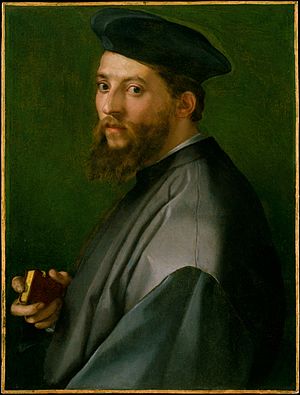
- Holy Family with St. Peter Martyr (1507-1508, Pinacoteca di Bari)
- Noli me tangere (c. 1510, Museo del Cenacolo di Andrea del Sarto, Florence)
- Virgin, Child, Elizabeth and John the Baptist (c. 1513, National Gallery, London)
- Portrait of the Artist's Wife (1513-1514, Museo del Prado, Madrid)
- Nativity of the Virgin (1513-1514, Santissima Annunziata, Florence)
- Madonna of the Harpies (1517, Uffizi, Florence)
- Portrait of a Young Man (1517-18, National Gallery, London)
- Charity (1518, Louvre, Paris)
- Julius Caesar Receives Tribute (c. 1520, fresco at Poggio a Caiano)
- Virgin Surrounded by Saints (Pitti Palace, Florence)
- Madonna della Scala (c. 1522-1523, Museo del Prado, Madrid)
- Panciatichi Assumption (c. 1522-1523, Galleria Palatina, Pitti Palace, Florence)
- Pietà (1523-1524, Galleria Palatina, Pitti Palace, Florence)
- Passerini Assumption (1526, Galleria Palatina, Pitti Palace, Florence)
- Last Supper (1511-1527, Museo del Cenacolo di Andrea del Sarto, Florence)
- The Disputation on the Trinity (c. 1528, Uffizi, Florence)
- Gambassi Altarpiece (c. 1528, Galleria Palatina, Pitti Palace, Florence)
- Barberini Holy Family (c. 1528, Galleria Nazionale di Arte Antica, Rome)
- St. James with Two Youngs (c. 1528-1529, Uffizi, Florence)
- Vallombrosa Polyptych (c. 1528-1529, Uffizi, Florence)
- Holy Family with John the Baptist (c. 1529, Hermitage, St. Petersburg)
- Borgherini Holy Family (c. 1529, Metropolitan Museum, New York)
- Medici Holy Family (c. 1529, Galleria Palatina, Palazzo Pitti, Florence)
- Madonna in Glory with Four Saints (1530, Galleria Palatina, Palazzo Pitti, Florence)
See Also
 In Spanish: Andrea del Sarto para niños
In Spanish: Andrea del Sarto para niños
- Illustrated Biographies of the Great Artists


